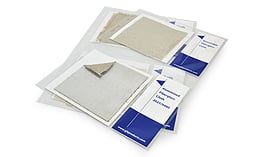
It is not unusual for someone to find disappointment after installing “soundproof" foam, blankets, or panels (ask any search engine for examples), only to discover that while the sound quality inside of the space has changed, the sound entering or escaping has not. The problem is that it is not actually "soundproof."
How is this possible, you may ask?
One of the top reasons for this is the common incorrect use of the term “Soundproof”. Although the term seems to be self-explanatory, it is often confused with the term "sound quality." In this blog post, we dive into the correct definition, and how to test products to produce your desired soundproofing results.
Soundproof by definition:
Adjective:
- Impervious to sound.
- Designed to prevent sound from entering or leaving.
- Not penetrable by sound.
Verb:
- To insulate to obstruct the passage of sound.
- Insulate against noise.
- Protect from noise by surrounding with insulating material.
Whether used as an adjective or verb, a soundproof(ed) space is one that simply keeps-in (and blocks-out) unwanted sound. It turns out that many “soundproofing” products provide no sound blocking properties. Foam, fiberglass, and other fibrous materials by themselves are sound absorbers, not barriers.
Absorbers are very useful for improving sound quality in a room that is too “loud” or “live”. They reduce reverberation, echoes, and overall noise levels by absorbing sound that would otherwise be reflected into a room and reinforced by hard surfaces. Unfortunately, they cannot soundproof (as correctly defined above) your space on their own.
Here are two quick-and-dirty tests for determining if a material has soundproofing potential:
The Chat Test: Find a relatively quiet location outdoors where there are no buildings or reflective surfaces nearby. Hold a sizeable sample of the material between you and a friend and have a conversation. While some sound will still travel around the material and some will travel directly through, a decent barrier material such as Vinaflex (VP) Noise Barrier (Mass Loaded Vinyl) should significantly impair the conversation. The larger the sample, the more accurate this test will be.
The Earblock Test: This one is a little trickier to execute. Seal-off your ears with a sample of the material while listening to a constant noise source such as a fan, then alternate covering and uncovering your ears. The degree to which the material does (or does not) block sound is an indicator of the results that it may have for soundproofing your space. Many people are particularly surprised when trying this test with popular acoustic foam tiles.
Of course, these ‘tests’ alone are not sufficient for making material decisions in your soundproofing project. Soundproofing done-right typically requires the strategic use of barrier materials in conjunction with absorptive materials. Much of soundproofing is not intuitive, so please feel free to contact us anytime to discuss your project. Experienced advice can go a long way in avoiding costly mistakes.
¹Definitions per: Merriam-Webster dictionary, Webster student dictionary, and Collins unabridged English Dictionary


